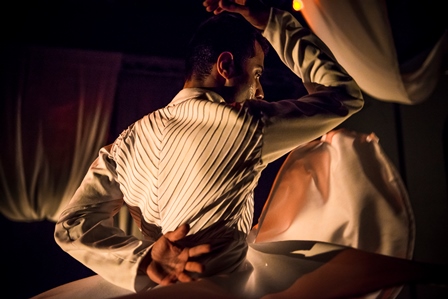1 May 2015 (matinee), Lennox Theatre Riverside, Parramatta
Tukre’ means ‘pieces’ in Hindi and Raghav Handa’s solo show was a series of moments from his life—memories, thoughts, recollections. These intimate pieces from his life as an Australian of Indian heritage were spread across about 50 minutes of dance, conversation and projections.

Handa is a beautiful mover and his qualities as a dancer were obvious from the first moments of Tukre’. In semi-darkness Handa bent over a small candle and acted out the faceting techniques of his Indian forbears, who were jewellery makers. Every movement was precise and clearly articulated. And from then on, while the movements became more expansive, and changed in dynamics, there was always the same precision of movement. Throughout the performance his clearly defined musculature allowed us to see his exceptional capacity to isolate movement in individual parts of the body.
There were references in his choreography to his background in Kathak dance, especially when he changed into a long garment, with a full skirt and finely detailed top, and began to turn with the skirt swirling around his body. There were also Indian references in the electronic score from composer Lachlan Bostock, which maintained beautifully the Indian/Western links apparent throughout Tukre’.
At times Handa stopped dancing and picked up a microphone to talk to us about his life. He told us of how his Australian life interacted with his Indian heritage and we were privy to a conversation with his mother, via a film clip projected onto a scrim hanging in the performance space. At first this halt to the movement was a little jarring, but slowly it became clear that this was the structure of Tukre’. We were seeing Handa as a multi-faceted person and artist. There were some particularly affecting moments in his conversation with his mother as they discussed his sexual orientation and the passing on to him of a family heirloom. In addition there was footage of his mother meticulously folding a sari, which was also affecting as it reflected the precision that marked Handa’s choreography. As the work closed we saw Handa wearing the heirloom, an ornate, bejewelled necklace.
I found Tukre’ quite fascinating as a work that set out to cross boundaries between cultures. It didn’t always flow as smoothly as it might have, and I continued to feel a sense of annoyance whenever Handa picked up a microphone and changed the mood of the piece so abruptly. But I look forward to seeing more of Handa’s work, which seems to me to be quite unique on the current dance scene.
Michelle Potter, 3 May 2015
Featured image: Raghav Handa in Tukre’. Photo: © Gregory Lorenzutti
